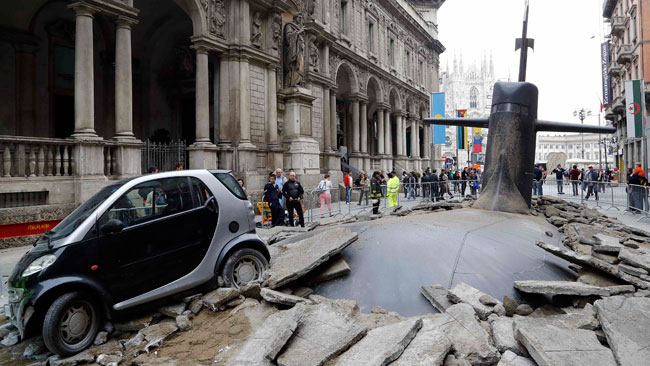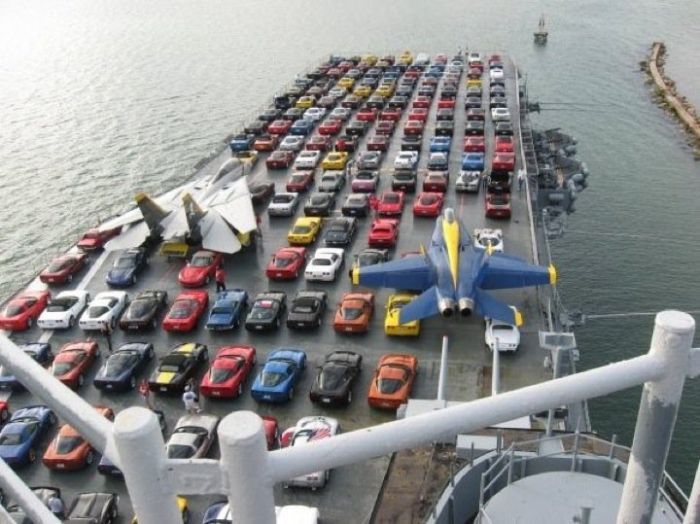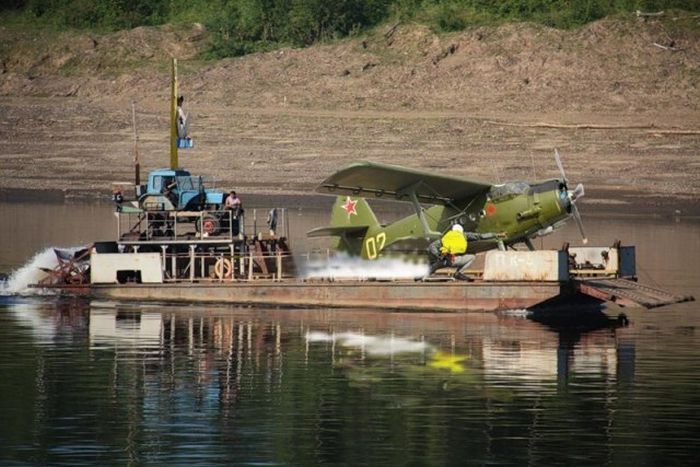32Dundee a écrit: Il a tapé une falaise au fond d'une fosse ou quoi???? Bizarre tout de même la façon dont la structure s'est déformée....
Il a percuté une falaise sous-marine non cartographiée en plongée à 30 nœuds !
Un mort et 60 blessés, tous projetés contre les cloisons et le matériel.
Le dôme du sonar avant a été pulvérisé.

Voici un compte-rendu de l'incident par un personnel du constructeur (Electric Boat) :
By ROBERT A. HAMILTON Day Staff Writer, Navy/Defense/Electric Boat
Published on 1/15/2005
New London -- The galley crew had started to serve lunch as the USS San Francisco checked its position against a global positioning system satellite, checked the water depth with its fathometer, and announced that the ship was going to dive, all routine operations aboard an attack submarine.
Four minutes after it submerged, that routine was shattered one week ago today as the San Francisco crashed into an undersea mountain at more than 35 mph, sending sailors crashing into equipment and bulkheads and destroying the bow dome and three of the main ballast tanks at the front of the sub.
one man was killed and more than 60 others were injured, two dozen of them seriously. But engineers are impressed that despite the violence of the underwater encounter, the ship's reactor, steam turbine generators, electrical distribution network and even its navigation system were unharmed, and the ship was able to limp back to port on its own.
Saturday morning, soon after breakfast ended at 6 a.m., the ship conducted a "field day," during which the entire ship is cleaned, top to bottom. All 137 men on board would have been out of their bunks and taking part until just before lunch was served at 11 a.m. They would have removed deck plates to clean bilges and other hard-to-reach spaces. The chief petty officers on board warned everyone as they finished to "stow for sea" - make sure everything is bolted down or locked up. In the event of a collision, loose objects tend to become unguided missiles. As a result, the ship was probably more tightly stowed than usual, which helped prevent more serious injuries, submariners said.
In late morning, the ship was at periscope depth, checking to make sure it was on course. Everything checked out; the ship was just over 400 miles southeast of Guam, near the Caroline Islands ridge, but the charts showed that there was no water less than about 6,000 feet deep for at least seven miles around the boat, more than enough of a safety margin for submariners, who are known to be cautious. Some time about 11:30, after running through a safety checklist to make sure the boat was ready to submerge, the officer of the deck gave the order to dive. The San Francisco used the dive to pick up speed, and was soon running at flank speed, something in excess of 30 knots. Although its destination was to the southwest, it was headed in an easterly direction, probably because it had "cleared its baffles," or changed direction to check to make sure there were no submarines trailing it in the spot directly behind the ship, where its normal sonar sensors cannot "hear."
At 11:42 a.m. Guam time, about four minutes after diving, the San Francisco crashed head-on into a nearly vertical wall of stone, a seamount that was not on the charts. In an instant, the submarine's speed dropped from almost 33 knots horizontal to 4 knots almost straight up as the bow whipped up and the ship tried to go over the obstacle - without success. Crewmen told family and friends that the moment was surreal, so unexpected that it took a moment to realize what had happened: The sub had rammed into something and was out of control. One sailor told a friend it reminded him of the movie "The Matrix," in which everything slows down and a disaster unfolds in slow motion. The diving officer of the watch, normally strapped into a chair in the control room, had just unbuckled his belt to update a status board. He struck the control panel so hard that he broke some of the gauges. Some crewmen were tossed 20 feet into bulkheads, several narrowly missing being dropped down through stairways. A couple of men were smoking in the lower level of the engine room, and more were waiting their turn - it is the only area in the sub where smoking is allowed. The area includes much sharp-edged metal equipment that caused several of the lacerations and broken bones that had to be treated later.
Machinist Mate 2nd Class Joseph Allen Ashley, 24, of Akron, Ohio, who had just re-enlisted for a second four-year term, was in the main seawater bay at the back of the sub. He was thrown forward 20 feet into the propulsion lube oil bay, striking his forehead against a large metal pump. He was knocked out and died the next day without regaining consciousness. Through the chaos, though, the crew followed the procedures they had drilled on day after day as submariners. Within seconds, one of the crewmen at the helm, his arm broken in the crash, pulled the "chicken switch," which forces high-pressure air into the main ballast tanks to force the submarine to the surface. The executive officer suffered a serious back injury when he was thrown onto an emergency air supply pipe, but he was quickly directing damage-control efforts. Injured men were carried to the crew's mess and the wardroom, where the tables were pressed into service as gurneys. The ship's "doc," an independent duty corpsman trained in emergency medicine, began assessing and treating the injuries. One of the ship's junior officers was a former enlisted man and was able to help out. Other crewmen were recruited to keep men with head injuries awake until they could be checked out, as the worst cuts were stitched and the worst breaks were set.
The submarine force has a policy of "water space management" that would have required Mooney, the skipper, to file a plan showing his expected track and speed through the area to make sure he would not be in the same water as another submarine at the same time. Navy sources said there was nothing on that plan that would have raised any alarm. In addition, given the charts that showed only deep water in the area, Mooney would not have been expected to do depth soundings more than every 30 minutes, certainly no more than every 15 minutes, which would not have given him enough time to react to the steep seamount. In fact, he might not have been able to avoid grounding even with nearly continuous soundings. The undersea mountain was so steep that there was damage visible even on the top of the sonar dome, which indicates that the sub hit a virtual wall. The San Francisco would have picked up the mountain if it was using active sonar, but submariners use that sparingly because it gives the boat's location away. Instead, it would have been using passive sonar - listening for the noises made by other ships and submarines. But seamounts don't make any noise, and even if there were currents swirling around it, the noise would have been lost in the noise the San Francisco was making as it sped through the water near top speed.
_Bruno
_________________
Hi Bob!
C'est curieux chez les marins ce besoin de faire des phrases
Si Vis Pacem Parafilmum
La sous-couche, c'est un apprêt que l'on met avant
Si on bricolait plus souvent on aurait moins la tête aux bêtises
Omnes stulti, et deliberationes non utentes, omnia tentant
Une journée au cours de laquelle on n'a pas ri est une journée perdue
Espérons que le fond de la mer est étanche
Oh, ça c'est le Quacta qui se moque du Stifling
Telle est la Voie !






















